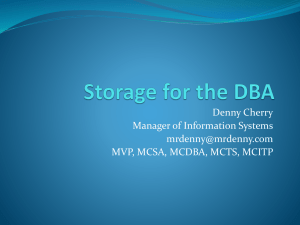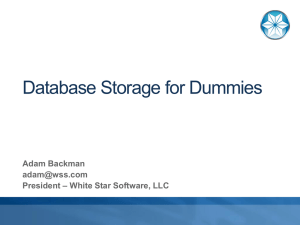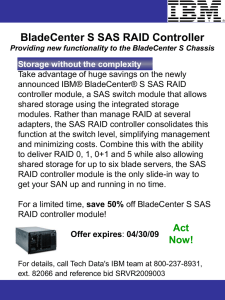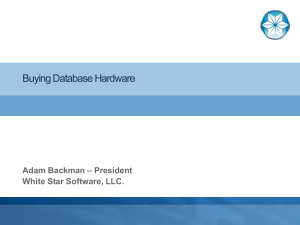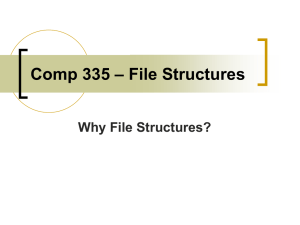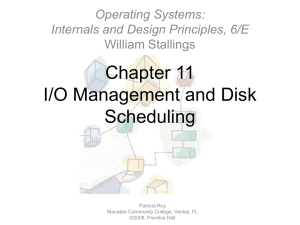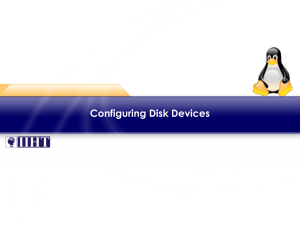width
advertisement
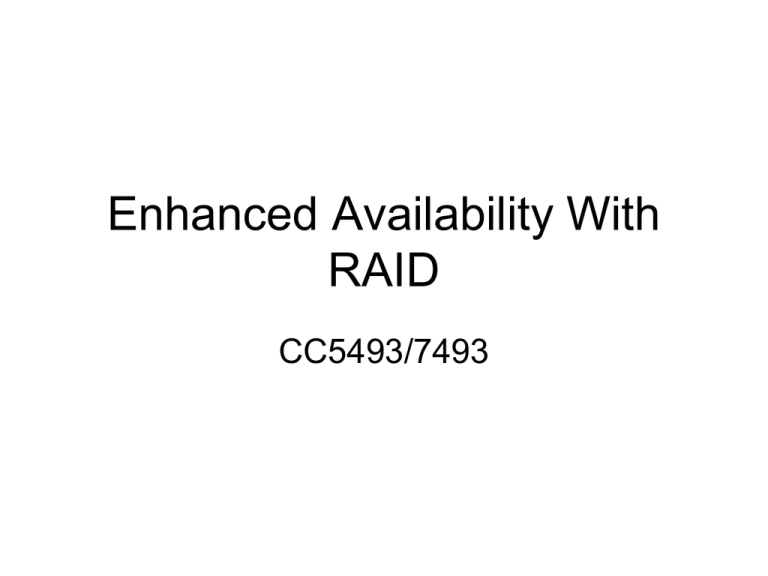
Enhanced Availability With RAID CC5493/7493 RAID • Redundant Array of Independent Disks • RAID is implemented to improve: – IO throughput (speed) and – Availability of a file system. RAID Implementation • Software – often criticized as not being a true RAID implementation. • Hardware – A special RAID controller is required. RAID: Stripe • The stripe takes on two meanings within the context of a RAID system: – Stripe width (number of independent drives) – Stripe size (storage block size) Both stripe width and stripe size are adjusted to enhance IO throughput. RAID Stripe Width • Stripe width refers to the number of disks used in parallel for IO transfers to and from the array. Raid Stripe Size • Stripe size refers to the size of the storage units organized on the disk surface. • The stripe size is adjusted to optimize the speed of the IO transfers. Common RAID Types • • • • • RAID-0 RAID-1 RAID-1+0, RAID-0+1 RAID-5 RAID-6 RAID-0 • • • • AKA disk striping Does not provide redundancy Degrades data availability, reduces MTF Improves IO throughput (average IO transfer rate improves) RAID-0 • Ideal for temporary storage requiring fast data access. -Engineering/Scientific calculations on large data volumes. However, the data is a redundant temporary copy. RAID-1 • AKA mirroring • Requires two independent disk devices – The first disk stores the data – The second disk is an image of the first – Can double the overall read throughput RAID-1 • width = 1 RAID-1 Advantages • Improves data availability. • Dual-channel controller allows for two simultaneous read operations. • Allows for error detection on read. • Administrative advantages for service on one drive while the other remains available. • Fault tolerance is one drive. RAID-1 Disadvantages • Writes have a slight performance penalty compared to no RAID. • Doubles the cost of storage. • Storage efficiency = 50% RAID-1 • Ideal for data that is read more often than written: – Some database information that is not updated often. – Web Server information (lots of reads, few writes) RAID-1+0 • Enhances IO throughput and data availability. • Requires 2(n+1) separate disk devices, where n = 1, 2, 3, 4, … – Minimum of 4 disks required (n=1) RAID-1+0 Width=2 RAID-1+0 • Width = 4 RAID-1+0 • RAID-1+0 has a higher fault tolerance compared to RAID-0,1, & 5. • Storage efficiency is 50% RAID-0+1 • Requires the same hardware as RAID1+0, but less fault tolerant. • However, there is better read throuthput from RAID-0+1 compared to RAID-1+0. RAID-0+1 • Duplicate RAID-0 arrays. Allows simultaneous reads RAID-5 • RAID-5 enhances – IO data throughput – Data availability • Parity information enhances availability • Requires a minimum of 3 independent disk devices. Parity Information • Based on the logical exclusive-or operation. RAID-5 Configuration • Stripe Width = 4 RAID-5 • The most common implementation of RAID. • Ideal for a disk-server providing general storage. • A good balance between reliability and speed. • Often implemented using high quality disk drives (SCSI, 15k-rpm, high MTF) RAID-5 Limitations • Overhead occurs during writes due to the parity calculation and parity write. • Storage efficiency is not 100% due to the parity storage requirements. storage efficiency = (n-1)/n, where n = number of drives. RAID-5 (S)ATA Limitations • Large capacity (S)ATA drives are more likely to contain bad blocks. • After a disk failure, the bad blocks make it impossible to rebuild the array from the remaining drives. RAID-6 • Contains two sets of parity. • Tolerates two simultaneous disk failures. • A better solution for (S)ATA arrays where each disk has a large capacity (multiple TB). • Stripe Width = 6 RAID-6 • Higher availability at the cost of greater IO overhead due to complex parity calculations and storage. • Storage efficiency = (n-2)/n • Becoming more popular for large storage capacity (S)ATA arrays RAID-6 Disadvantages • More expensive to implement due to extra parity information • Slower write operations compared to other RAID-5 RAID Disk Swapping • Hot Swap • Warm Swap • Cold Swap Hot Swap • The ability to swap out a failed disk from a RAID array without an interruption of service from the array. • Performance will be slower due to the operations required to rebuild the new replacement disk. Warm Swap • The array is not accessible while a drive is being serviced, but the system does not need to be shut down. Cold Swap • System must be shutdown to service the array. Spare Disk: Hot Spare • Some RAID controllers can be configured to immediately recover from a disk failure if a hot-spare disk is connected to the controller at all times. RAID Disk Failure and Performance • When a failed disk is replaced in an array, there is a performance hit as the new disk must be re-populated with the required data for the complete array. RAID Summary • RAID-0 : for temporary storage only • RAID-1 : ideal for disk services that provide mostly read operations like data base services and web services. • RAID-5 : general purpose disk-server • RAID-6 : for very large data requirement environments (multiple T-Bytes). RAID Summary • RAID 1+0 : general purpose disk server where RAID-5 & 6 are not adequate. – Better fault tolerance – More IO throughput Other? • RAID 1+1, mirror a mirrored RAID-1 – Triples the cost of storage – Excellent fault tolerance. – Excellent read throughput. – Writes will suffer
